Advanced Numerical Free Vibration Analysis of FG Thin-Walled I-Beams Using Refined Beam Models
Abstract
1. Introduction
2. The Refined Beam Theory RBT
2.1. The Original Model
2.2. A Refined Beam Theory Using the Distortional Modes RBT*
- are the six SV’s 3D modes associated with the 6 cross-section stresses without splitting them into in-plane modes and out-of-plane modes , respectively.
- are additional modes that used in a thin- or thick-walled segment or in highly differentiated composite sections, where these modes represent the first m 3D mode shapes associated with the free vibration of the cross-section, which mainly reflect the sectional distortions.
2.3. Cross-Section Analysis Problem
2.3.1. Analysis of the Saint-Venant Cross-Section
2.3.2. Dynamic Analysis of the Cross-Section
2.4. Free Vibration of a Composite Beam
The 1D Problem
3. Constitutive Equations for an FGM Beam
4. Numerical Implementation (RBT/SV and 3D FEM Computations)
5. Numerical Results
5.1. Cross-Section Analysis
5.2. Example 1
5.3. Example 2
5.4. Example 3
6. Conclusions
Author Contributions
Funding
Data Availability Statement
Conflicts of Interest
References
- Koizumi, M. FGM activities in Japan. Compos. B Eng. 1997, 28, 1–4. [Google Scholar] [CrossRef]
- Koizumi, M.; Niino, M. Overview of FGM research in Japan. MRS Bull. 1995, 20, 19–21. [Google Scholar] [CrossRef]
- Kawasaki, A.; Watanabe, R. Concept and P/M fabrication of functionally gradient materials. Ceram. Int. 1997, 23, 73–83. [Google Scholar] [CrossRef]
- Ali, E.; Woldeyes, K.; Urgessa, G. Fire performance of functionally-graded-material sheathed load bearing thin-walled structural framing. Fire Saf. J. 2021, 125, 103425. [Google Scholar] [CrossRef]
- Reddy, J.N. Analysis of functionally graded plates. Int. J. Numer. Methods Eng. 2000, 47, 663–684. [Google Scholar] [CrossRef]
- Bodaghi, M.; Saidi, A.R. Levy-type solution for buckling analysis of thick functionally graded rectangular plates based on the higher-order shear deformation plate theory. Appl. Math. Model. 2010, 34, 3659–3673. [Google Scholar] [CrossRef]
- Sofiyev, A.H. The vibration and stability behavior of freely supported FGM conical shells subjected to external pressure. Compos. Struct. 2009, 89, 356–366. [Google Scholar] [CrossRef]
- Sofiyev, A. Buckling analysis of FGM circular shells under combined loads and resting on the Pasternak type elastic foundation. Mech. Res. Commun. 2010, 37, 539–544. [Google Scholar] [CrossRef]
- Ke, L.-L.; Wang, Y.-S. Size effect on dynamic stability of functionally graded microbeams based on a modified couple stress theory. Compos. Struct. 2011, 93, 342–350. [Google Scholar] [CrossRef]
- Nateghi, A.; Salamat-talab, M.; Rezapour, J.; Daneshian, B. Size dependent buckling analysis of functionally graded micro beams based on modified couple stress theory. Appl. Math. Model. 2012, 36, 4971–4987. [Google Scholar] [CrossRef]
- Neves, A.M.A.; Ferreira, A.; Carrera, E.; Cinefra, M.; Roque, C.; Jorge, R.M.N.; Soares, C.M.M. Static, free vibration and buckling analysis of isotropic and sandwich functionally graded plates using a quasi-3D higher-order shear deformation theory and a meshless technique. Compos. B Eng. 2013, 44, 657–674. [Google Scholar] [CrossRef]
- Barati, M.R.; Shahverdi, H. Aero-hygro-thermal stability analysis of higher-order refined supersonic FGM panels with even and uneven porosity distributions. J. Fluids Struct. 2017, 73, 125–136. [Google Scholar] [CrossRef]
- Wang, Y.; Feng, C.; Zhao, Z.; Yang, J. Eigenvalue buckling of functionally graded cylindrical shells reinforced with graphene platelets (GPL). Compos. Struct. 2018, 202, 38–46. [Google Scholar] [CrossRef]
- Mahmoudi, A.; Benyoucef, S.; Tounsi, A.; Benachour, A.; Bedia, E.A.A.; Mahmoud, S.R. A refined quasi-3D shear deformation theory for thermo-mechanical behavior of functionally graded sandwich plates on elastic foundations. J. Sandw. Struct. Mater. 2019, 21, 1906–1929. [Google Scholar] [CrossRef]
- El-Ashmawy, A.M.; Xu, Y. Longitudinal modeling and properties tailoring of functionally graded carbon nanotube reinforced composite beams: A novel approach. Appl. Math. Model. 2020, 88, 161–174. [Google Scholar] [CrossRef]
- Sun, S.; Zhang, X.; Li, X. A consistent shear beam theory for free vibration of functionally graded beams based on physical neutral plane. Mech. Adv. Mater. Struct. 2023, 31, 3844–3854. [Google Scholar] [CrossRef]
- Turan, M.; Adiyaman, G. A New Higher-Order Finite Element for Static Analysis of Two-Directional Functionally Graded Porous Beams. Arab. J. Sci. Eng. 2023, 48, 13303–13321. [Google Scholar] [CrossRef]
- Van Vinh, P.; Van Chinh, N.; Tounsi, A. Static bending and buckling analysis of bi-directional functionally graded porous plates using an improved first-order shear deformation theory and FEM. Eur. J. Mech. A/Solids 2022, 96, 104743. [Google Scholar] [CrossRef]
- Boumezbeur, K.; Khebizi, M.; Guenfoud, M.; Guendouz, I. Mechanical Response of Thin Composite Beams Made of Functionally Graded Material Using Finite Element Method. Period. Polytech. Civ. Eng. 2023, 67, 970–982. [Google Scholar] [CrossRef]
- Guendouz, I.; Guenfoud, H.; Khebizi, M.; Boumezbeur, K.; Guenfoud, M. Buckling analysis of thin-walled laminated composite or functionally graded sandwich I-beams using a refined beam theory. Mech. Based Des. Struct. Mach. 2024, 1–21. [Google Scholar] [CrossRef]
- Şimşek, M.; Kocatürk, T. Free and forced vibration of a functionally graded beam subjected to a concentrated moving harmonic load. Compos. Struct. 2009, 90, 465–473. [Google Scholar] [CrossRef]
- Larbi, L.O.; Kaci, A.; Houari, M.S.A.; Tounsi, A. An Efficient Shear Deformation Beam Theory Based on Neutral Surface Position for Bending and Free Vibration of Functionally Graded Beams. Mech. Based Des. Struct. Mach. 2013, 41, 421–433. [Google Scholar] [CrossRef]
- Shahba, A.; Attarnejad, R.; Marvi, M.T.; Hajilar, S. Free vibration and stability analysis of axially functionally graded tapered Timoshenko beams with classical and non-classical boundary conditions. Compos. B Eng. 2011, 42, 801–808. [Google Scholar] [CrossRef]
- Sankar, B.V. An elasticity solution for functionally graded beams. Compos. Sci. Technol. 2001, 61, 689–696. [Google Scholar] [CrossRef]
- Thai, H.-T.; Vo, T.P. Bending and free vibration of functionally graded beams using various higher-order shear deformation beam theories. Int. J. Mech. Sci. 2012, 62, 57–66. [Google Scholar] [CrossRef]
- Hadji, L.; Khelifa, Z.; El Abbes, A.B. A new higher order shear deformation model for functionally graded beams. KSCE J. Civ. Eng. 2016, 20, 1835–1841. [Google Scholar] [CrossRef]
- Şimşek, M. Fundamental frequency analysis of functionally graded beams by using different higher-order beam theories. Nucl. Eng. Des. 2010, 240, 697–705. [Google Scholar] [CrossRef]
- Aydogdu, M.; Taskin, V. Free vibration analysis of functionally graded beams with simply supported edges. Mater. Des. 2007, 28, 1651–1656. [Google Scholar] [CrossRef]
- Kadoli, R.; Akhtar, K.; Ganesan, N. Static analysis of functionally graded beams using higher order shear deformation theory. Appl. Math. Model. 2008, 32, 2509–2525. [Google Scholar] [CrossRef]
- Li, X.-F.; Wang, B.-L.; Han, J.-C. A higher-order theory for static and dynamic analyses of functionally graded beams. Arch. Appl. Mech. 2010, 80, 1197–1212. [Google Scholar] [CrossRef]
- Wattanasakulpong, N.; Prusty, B.G.; Kelly, D.W. Thermal buckling and elastic vibration of third-order shear deformable functionally graded beams. Int. J. Mech. Sci. 2011, 53, 734–743. [Google Scholar] [CrossRef]
- Giunta, G.; Belouettar, S.; Carrera, E. Analysis of FGM beams by means of classical and advanced theories. Mech. Adv. Mater. Struct. 2010, 17, 622–635. [Google Scholar] [CrossRef]
- Giunta, G.; Belouettar, S.; Carrera, E. Analysis of FGM beams by means of a unified formulation. In IOP Conference Series: Materials Science and Engineering; IOP Publishing: Bristol, UK, 2010; p. 12073. [Google Scholar]
- Vlasov, V.Z. Thin-walled elastic beams. PST Cat. 1961, 428. [Google Scholar]
- Dos Reis, H.L.M.; Goldman, R.B.; Verstrate, P.H. Thin-walled laminated composite cylindrical tubes: Part III—Bending analysis. J. Compos. Technol. Res. 1987, 9, 58–62. [Google Scholar]
- Lee, J.; Kim, S.-E. Flexural–torsional coupled vibration of thin-walled composite beams with channel sections. Comput. Struct. 2002, 80, 133–144. [Google Scholar] [CrossRef]
- Mohri, F.; Azrar, L.; Potier-Ferry, M. Vibration analysis of buckled thin-walled beams with open sections. J. Sound Vib. 2004, 275, 434–446. [Google Scholar] [CrossRef]
- Lee, J.; Kim, S.-E. Free vibration of thin-walled composite beams with I-shaped cross-sections. Compos. Struct. 2002, 55, 205–215. [Google Scholar] [CrossRef]
- El Fatmi, R. A refined 1D beam theory built on 3D Saint-Venant’s solution to compute homogeneous and composite beams. J. Mech. Mater. Struct. 2016, 11, 345–378. [Google Scholar] [CrossRef]
- Lahmar, M.; Naccache, F.; El Fatmi, R. Thermo-mechanical analysis of composite beams. Compos. Struct. 2017, 162, 388–400. [Google Scholar] [CrossRef]
- Naccache, F.; El Fatmi, R. Numerical free vibration analysis of homogeneous or composite beam using a refined beam theory built on Saint Venant’s solution. Comput. Struct. 2018, 210, 102–121. [Google Scholar] [CrossRef]
- Ilies, G.; Hamza, G.; Mohamed, G.; Mourad, K.; El Fatmi, R. Bending-torsional behavior analysis using a refined beam theory. Rugc 2021, 39, 2019–2022. [Google Scholar]
- Phi, L.T.M.; Nguyen, T.T.; Lee, J. Buckling analysis of open-section beams with thin-walled functionally graded materials along the contour direction. Eur. J. Mech. A/Solids 2021, 88, 104217. [Google Scholar] [CrossRef]
- Nguyen, T.-T.; Kim, N.-I.; Lee, J. Free vibration of thin-walled functionally graded open-section beams. Compos. B Eng. 2016, 95, 105–116. [Google Scholar] [CrossRef]
- Nguyen, T.T.; Thang, P.T.; Lee, J. Flexural-torsional stability of thin-walled functionally graded open-section beams. Thin-Walled Struct. 2017, 110, 88–96. [Google Scholar] [CrossRef]
- Guendouz, I.; Khebizi, M.; Guenfoud, H.; Guenfoud, M.; El Fatmi, R. Analysis of torsional-bending FGM beam by 3D Saint-Venant refined beam theory. Struct. Eng. Mech. 2022, 84, 423. [Google Scholar]
- Guendouz, I.; Khebizi, M.; Guenfoud, H.; Guenfoud, M. Analysis of FGM Cantilever Beams under Bending-torsional Behavior Using a Refined 1D Beam Theory. Period. Polytech. Civ. Eng. 2022, 66, 1262–1277. [Google Scholar] [CrossRef]
- El Fatmi, R.; Zenzri, H. On the structural behavior and the Saint Venant solution in the exact beam theory: Application to laminated composite beams. Comput. Struct. 2002, 80, 1441–1456. [Google Scholar] [CrossRef]
- El Fatmi, R. A Matlab tool to compute the mechanical characteristics of any composite section. Rev. Des Compos. Des Matériaux Avancés–No 2012, 395, 413. [Google Scholar]
- Guenfoud, H.; Ziou, H.; Himeur, M.; Guenfoud, M. Analyses of a composite functionally graded material beam with a new transverse shear deformation function. J. Appl. Eng. Sci. Technol. 2016, 2, 105–113. [Google Scholar] [CrossRef]
- Ziou, H.; Guenfoud, M.; Guenfoud, H. A simple higher-order shear deformation theory for static bending analysis of functionally graded beams. Jordan J. Civ. Eng. 2021, 15, 209–224. [Google Scholar]
- Naccache, F.; El Fatmi, R. Buckling analysis of homogeneous or composite I-beams using a 1D refined beam theory built on Saint Venant’s solution. Thin-Walled Struct. 2018, 127, 822–831. [Google Scholar] [CrossRef]
- Sheikh, A.H.; Asadi, A.; Thomsen, O.T. Vibration of thin-walled laminated composite beams having open and closed sections. Compos. Struct. 2015, 134, 209–215. [Google Scholar] [CrossRef]
- Vo, T.P.; Lee, J. Flexural-torsional coupled vibration and buckling of thin-walled open section composite beams using shear-deformable beam theory. Int. J. Mech. Sci. 2009, 51, 631–641. [Google Scholar] [CrossRef]
- Nguyen, N.D.; Nguyen, T.K.; Vo, T.P.; Nguyen, T.N.; Lee, S. Vibration and buckling behaviours of thin-walled composite and functionally graded sandwich I-beams. Compos. B Eng. 2019, 166, 414–427. [Google Scholar] [CrossRef]
- Kim, N.I.; Shin, D.K.; Park, Y.S. Dynamic stiffness matrix of thin-walled composite I-beam with symmetric and arbitrary laminations. J. Sound Vib. 2008, 318, 364–388. [Google Scholar] [CrossRef]
- Yang, H.; Daneshkhah, E.; Augello, R.; Xu, X.; Carrera, E. Numerical vibration correlation technique for thin-walled composite beams under compression based on accurate refined finite element. Compos. Struct. 2022, 280, 114861. [Google Scholar] [CrossRef]

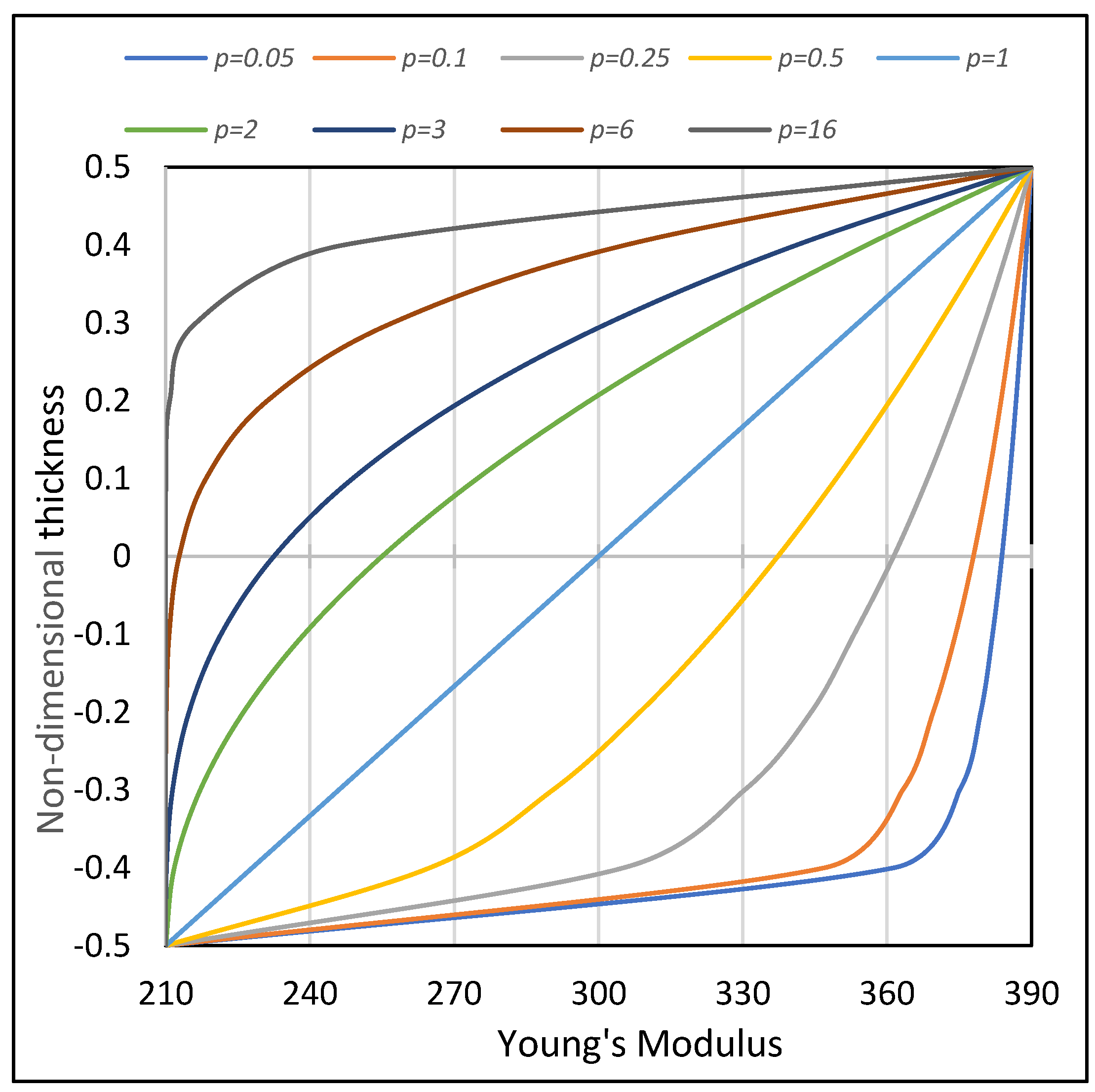
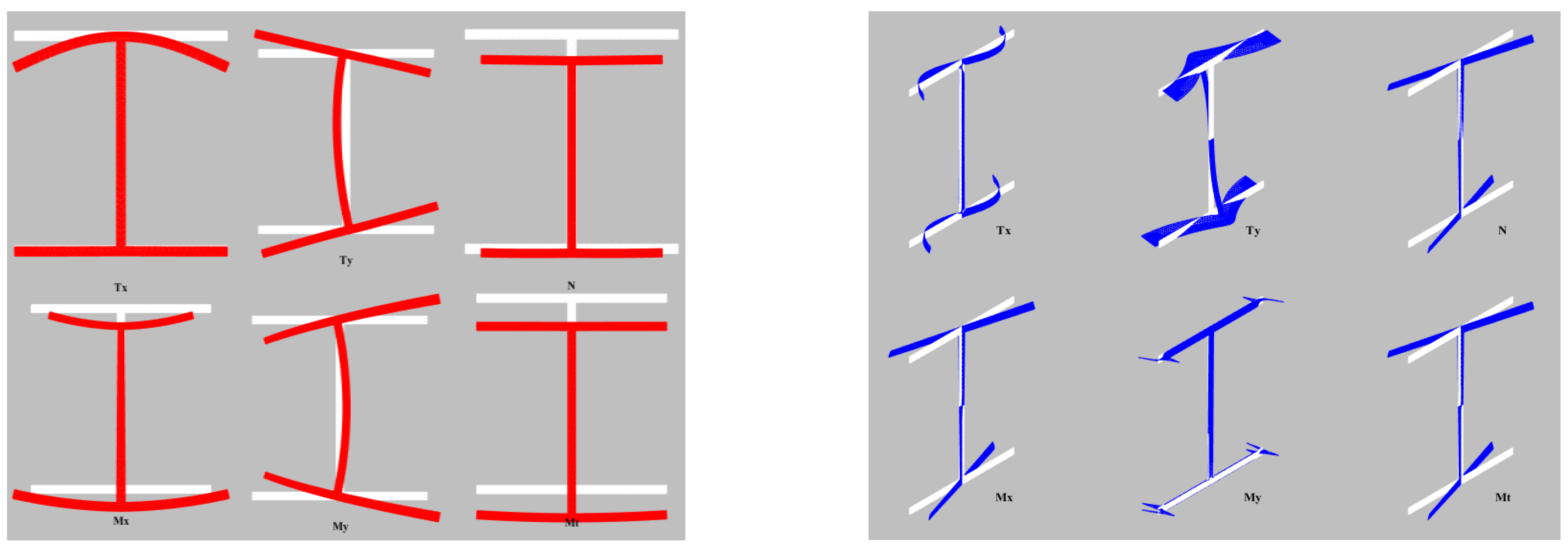


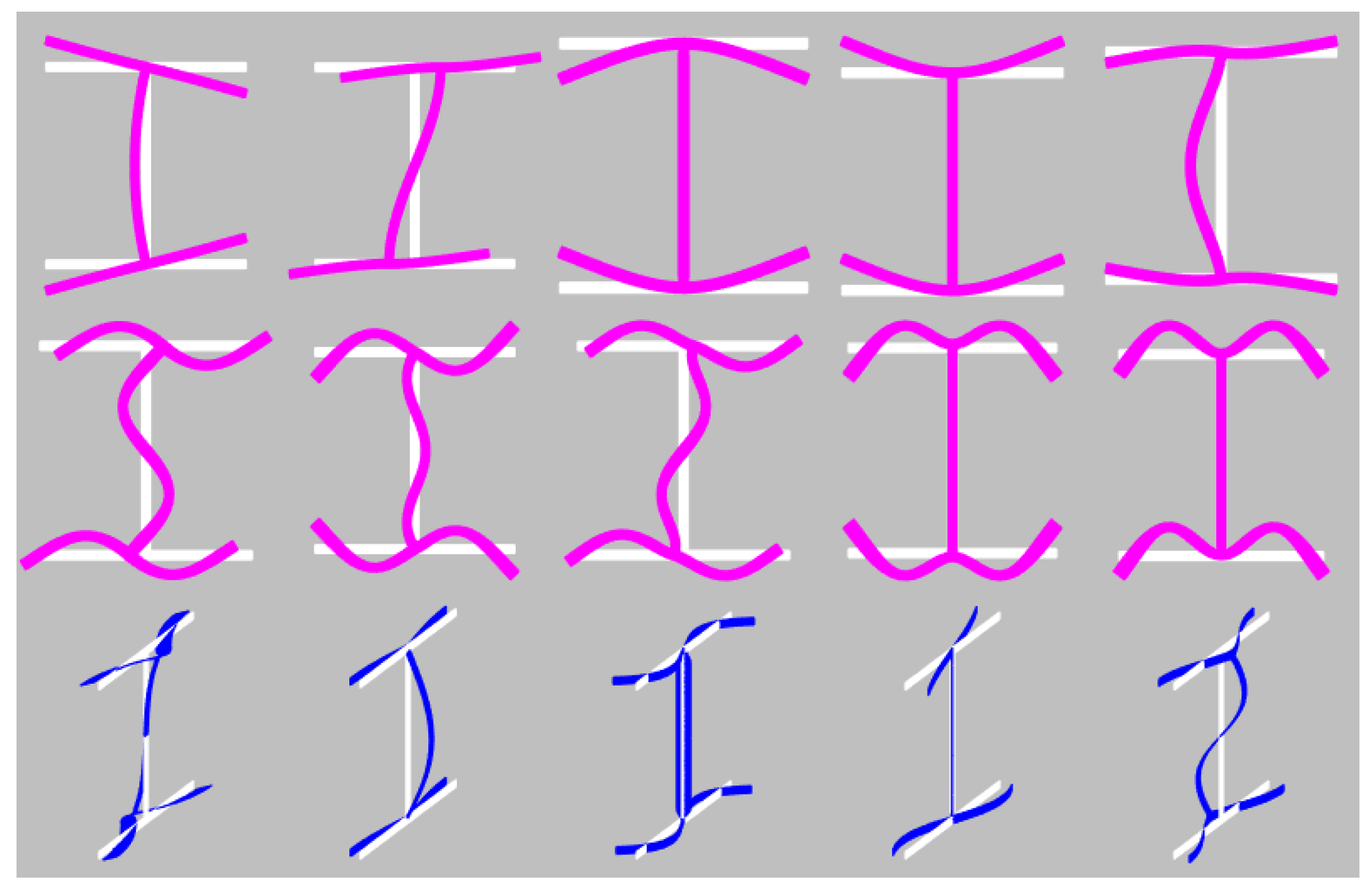


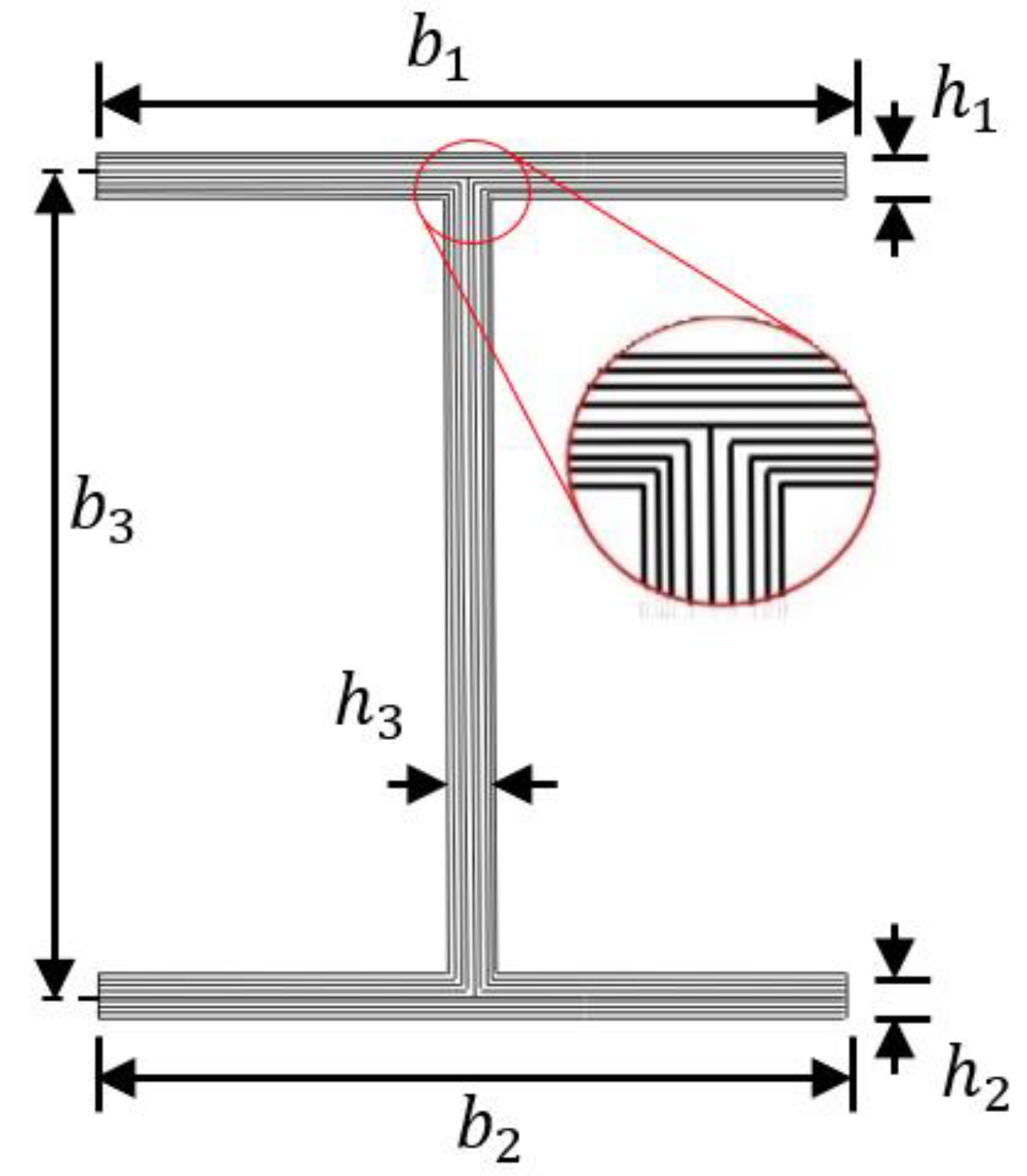

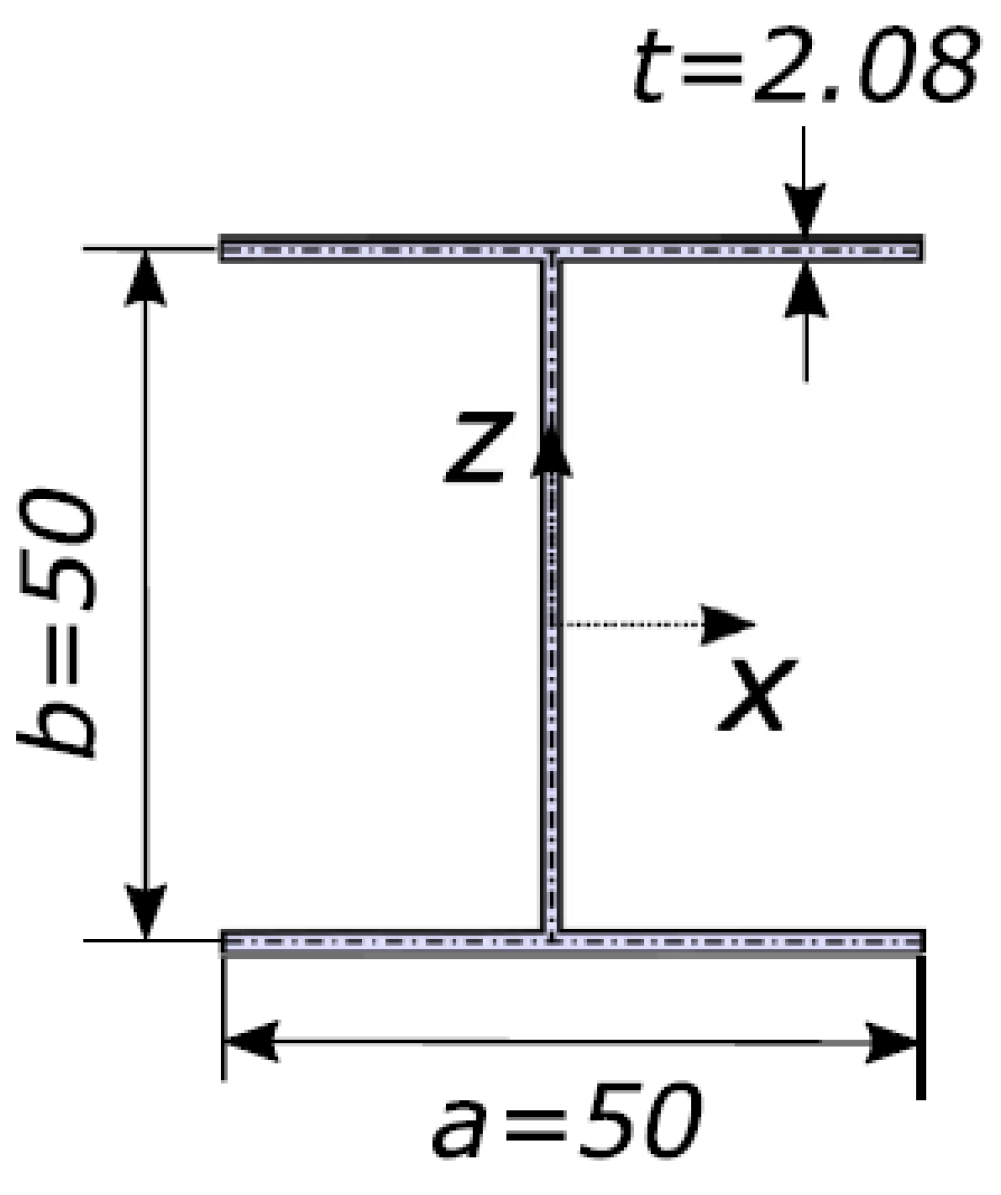

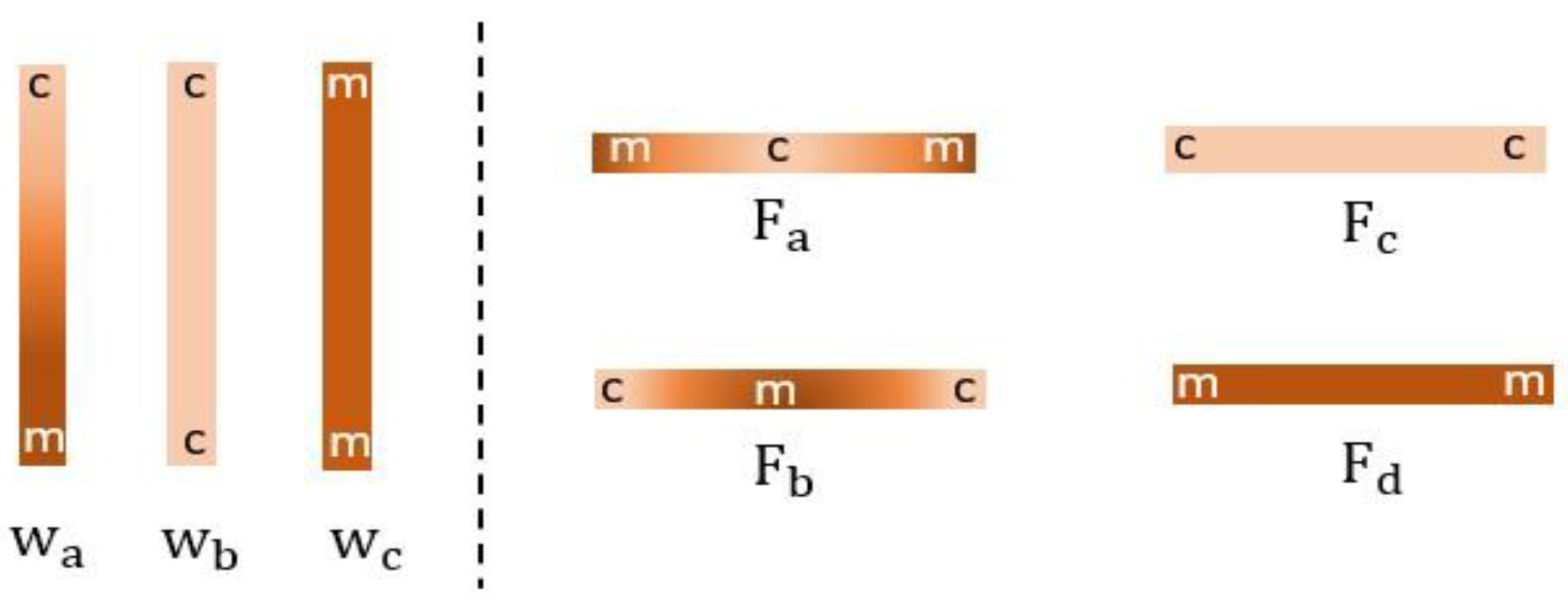


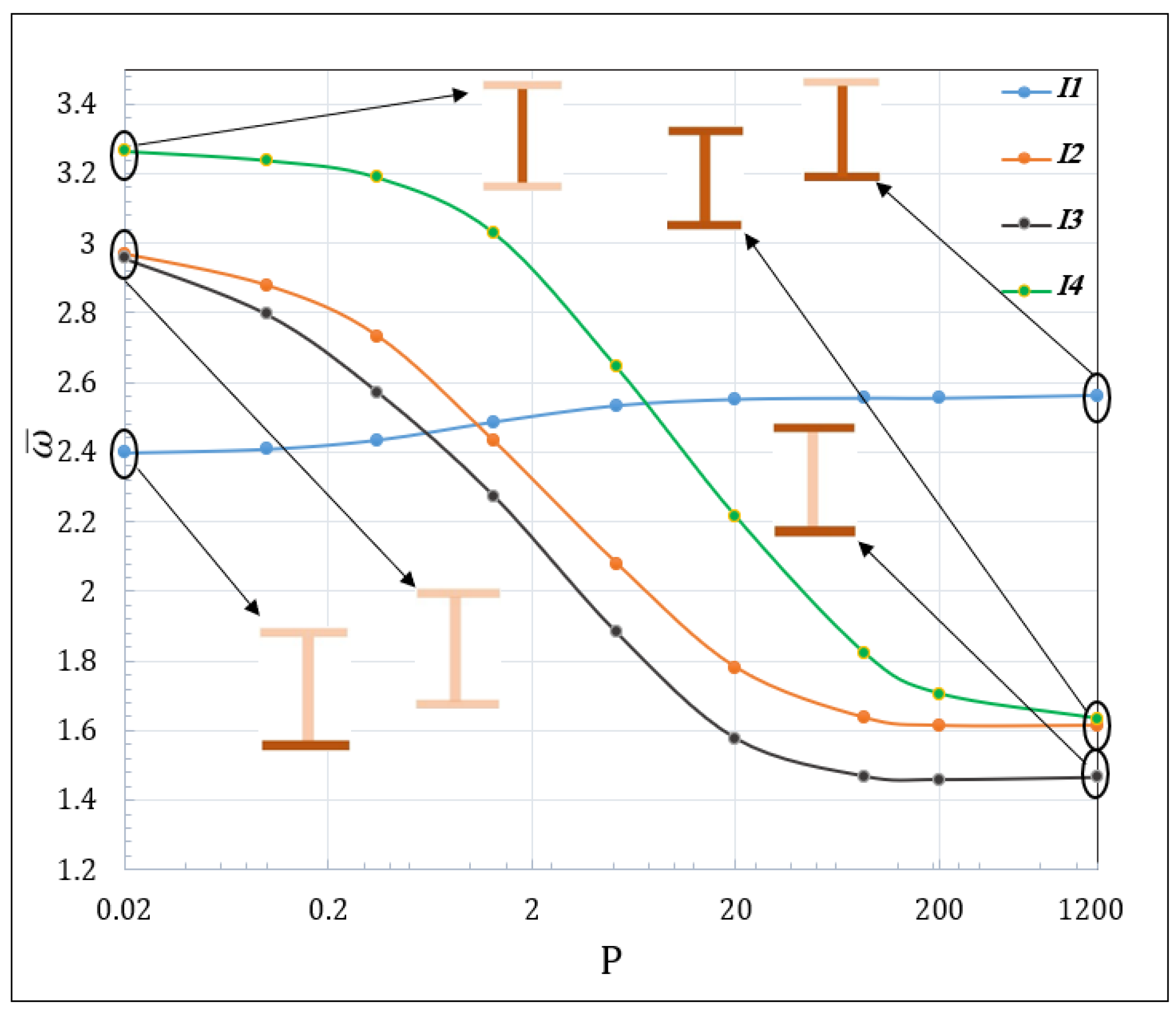
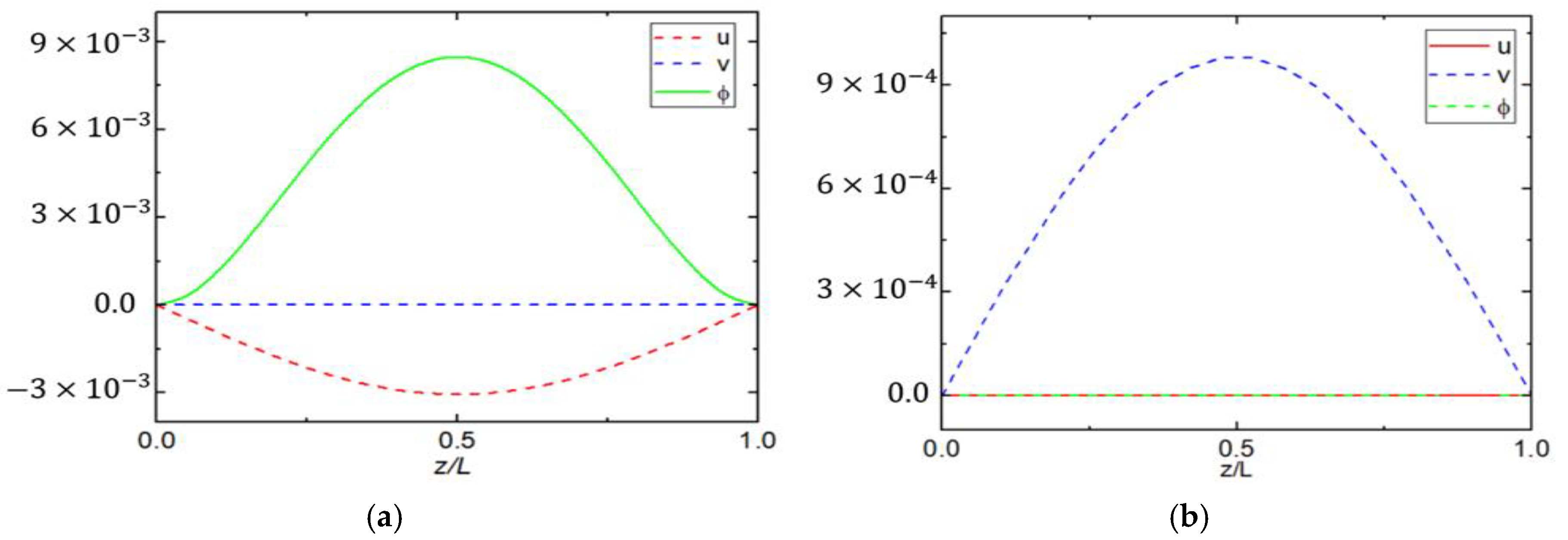


| BCs | Reference | Lay-Up | ||||||
|---|---|---|---|---|---|---|---|---|
| Present (RBT) | 24.490 | 23.250 | 20.006 | 16.700 | 14.806 | 14.268 | 14.160 | |
| Present (RBT*) | 24.491 | 23.253 | 20.004 | 16.700 | 14.808 | 14.268 | 14.162 | |
| S–S | Sheikh et al. [53] (Shear) | 24.160 | 22.970 | 19.800 | 16.480 | 14.660 | 14.070 | 13.960 |
| Vo and Lee [54] (Shear) | 24.150 | 22.955 | 19.719 | 16.446 | 14.627 | 14.042 | 13.937 | |
| Ngoc et al. [55] (Shear) | 24.169 | 22.977 | 19.806 | 16.481 | 14.668 | 14.071 | 13.964 | |
| Ngoc et al. [55] (No Shear) | 24.198 | 23.001 | 19.820 | 16.490 | 14.660 | 14.079 | 13.972 | |
| Kim et al. [56] (No Shear) | 24.194 | 22.997 | 19.816 | 16.487 | 14.666 | 14.077 | 13.970 |
| 53.78 | 17.93 | 8.96 | 0.25 | 1968.9 |
| Mode Number | Lamination | (60) Lamination | ||||||
|---|---|---|---|---|---|---|---|---|
| RBT | RBT* | CUF-LE [57] | Abaqus [57] | RBT | RBT* | CUF-LE [57] | Abaqus [57] | |
| Mode 1 | 34.87 | 34.84 | 34.36 | 34.36 | 20.97 | 20.96 | 20.83 | 20.68 |
| Mode 2 | 49.55 | 49.44 | 48.45 | 47.78 | 36.87 | 36.87 | 38.30 | 38.41 |
| Mode 3 | 60.68 | 60.65 | 62.98 | 63.03 | 42.55 | 42.38 | 40.91 | 41.21 |
| Mode 4 | 213.91 | 213.54 | 211.38 | 209.75 | 130.43 | 130.36 | 129.38 | 128.52 |
| Mode 5 | 236.46 | 233.94 | 230.05 | 228.05 | 220.54 | 170.36 | 162.26 | 162.57 |
| Mode 6 | 340.18 | 337.70 d | 348.77 | 347.48 | 171.70 * | 220.15 d | 228.31 | 230.35 |
| Mode 7 | 579.88 | 576.58 d | 512.89 | 505.47 | 360.86 | 360.23 | 353.61 | 353.79 |
| Mode 8 | 611.51 | 594.00 | 522.66 | 512.18 | 414.76 | 409.26 | 387.17 | 386.31 |
| Mode 9 | 833.08 | 626.80 | 547.02 | 536.28 | 577.64 | 572.90 d | 538.53 | 600.26 |
| Mode 10 | 1088.10 | 807.38 d | 570.67 | 562.32 | 695.19 | 692.36 d | 559.06 | 660.61 |
| BCs | Section | N-Fs | Theory | P-FGM | |||||||||
|---|---|---|---|---|---|---|---|---|---|---|---|---|---|
| 0 | 0.02 | 0.1 | 0.35 | 1.3 | 5.2 | 20 | 85 | 200 | 1200 | ||||
| RBT | 0.858 | 0.860 | 0.863 | 0.873 | 0.893 | 0.911 | 0.914 | 0.915 | 0.915 | 0.916 | |||
| RBT* | 0.855 | 0.857 | 0.861 | 0.871 | 0.890 | 0.908 | 0.912 | 0.913 | 0.913 | 0.914 | |||
| 3D FEM | 0.856 | 0.858 | 0.862 | 0.872 | 0.891 | 0.910 | 0.913 | 0.914 | 0.914 | 0.915 | |||
| RBT | 2.644 | 2.606 | 2.557 | 2.444 | 2.241 | 2.167 | 2.173 | 2.175 | 2.175 | 2.176 | |||
| RBT* | 2.644 | 2.606 | 2.557 | 2.444 | 2.241 | 2.166 | 2.173 | 2.175 | 2.175 | 2.175 | |||
| 3D FEM | 2.649 | 2.610 | 2.561 | 2.449 | 2.246 | 2.171 | 2.176 | 2.178 | 2.178 | 2.179 | |||
| RBT | 1.080 | 1.045 | 1.028 | 0.985 | 0.870 | 0.726 | 0.654 | 0.647 | 0.643 | 0.643 | |||
| RBT* | 1.077 | 1.041 | 1.025 | 0.949 | 0.868 | 0.724 | 0.652 | 0.645 | 0.642 | 0.641 | |||
| 3D FEM | 1.079 | 1.043 | 1.027 | 0.983 | 0.869 | 0.725 | 0.653 | 0.646 | 0.643 | 0.641 | |||
| RBT | 3.332 | 3.280 | 3.223 | 3.071 | 2.686 | 2.292 | 1.934 | 1.878 | 1.872 | 1.871 | |||
| RBT* | 3.332 | 3.181 | 3.222 | 3.071 | 2.686 | 2.292 | 1.934 | 1.877 | 1.871 | 1.870 | |||
| C–F | 3D FEM | 3.338 | 3.282 | 3.225 | 3.073 | 2.689 | 2.294 | 1.937 | 1.880 | 1.874 | 1.872 | ||
| RBT | 1.080 | 1.017 | 0.966 | 0.872 | 0.666 | 0.557 | 0.532 | 0.521 | 0.518 | 0.517 | |||
| RBT* | 1.077 | 1.014 | 0.962 | 0.870 | 0.663 | 0.555 | 0.529 | 0.519 | 0.516 | 0.515 | |||
| 3D FEM | 1.079 | 1.016 | 0.965 | 0.871 | 0.663 | 0.555 | 0.530 | 0.520 | 0.517 | 0.515 | |||
| RBT | 3.332 | 3.268 | 3.222 | 3.087 | 2.754 | 2.351 | 2.202 | 2.194 | 2.194 | 2.191 | |||
| RBT* | 3.332 | 3.268 | 3.222 | 3.087 | 2.754 | 2.350 | 2.202 | 2.194 | 2.194 | 2.191 | |||
| 3D FEM | 3.338 | 3.274 | 3.228 | 3.093 | 2.760 | 2.357 | 2.208 | 2.200 | 2.198 | 2.197 | |||
| RBT | 1.161 | 1.161 | 1.157 | 1.139 | 1.068 | 0.884 | 0.749 | 0.701 | 0.690 | 0.677 | |||
| RBT* | 1.158 | 1.157 | 1.154 | 1.136 | 1.065 | 0.881 | 0.746 | 0.699 | 0.689 | 0.675 | |||
| 3D FEM | 1.161 | 1.161 | 1.156 | 1.138 | 1.067 | 0.883 | 0.748 | 0.700 | 0.690 | 0.676 | |||
| RBT | 3.250 | 3.189 | 3.152 | 3.033 | 2.687 | 2.142 | 1.909 | 1.898 | 1.891 | 1.890 | |||
| RBT* | 3.250 | 3.189 | 3.152 | 3.033 | 2.686 | 2.141 | 1.909 | 1.898 | 1.924 | 1.890 | |||
| 3D FEM | 3.165 | 3.125 | 3.095 | 3.003 | 2.632 | 2.121 | 1.910 | 1.889 | 1.891 | 1.890 |
| BCs | Section | N-Fs | Theory | P-FGM | |||||||||
|---|---|---|---|---|---|---|---|---|---|---|---|---|---|
| 0 | 0.02 | 0.1 | 0.35 | 1.3 | 5.2 | 20 | 85 | 200 | 1200 | ||||
| RBT | 3.607 | 3.628 | 3.644 | 3.680 | 3.747 | 3.798 | 3.779 | 3.749 | 3.748 | 3.748 | |||
| RBT* | 3.594 | 3.617 | 3.632 | 3.667 | 3.735 | 3.786 | 3.771 | 3.746 | 3.746 | 3.746 | |||
| 3D FEM | 3.478 | 3.488 | 3.499 | 3.527 | 3.567 | 3.602 | 3.550 | 3.540 | 3.538 | 3.537 | |||
| RBT | 8.479 | 8.447 | 8.424 | 8.333 | 8.119 | 7.900 | 7.822 | 7.805 | 7.805 | 7.805 | |||
| RBT* | 8.453 | 8.420 | 8.397 | 8.304 | 8.087 | 7.862 | 7.796 | 7.779 | 7.778 | 7.778 | |||
| 3D FEM | 7.418 | 7.395 | 7.336 | 7.205 | 6.917 | 6.783 | 6.580 | 6.558 | 6.552 | 6.552 | |||
| RBT | 4.729 | 4.577 | 4.500 | 4.278 | 3.672 | 3.039 | 2.796 | 2.775 | 2.774 | 2.774 | |||
| RBT* | 4.711 | 4.546 | 4.469 | 4.247 | 3.641 | 3.025 | 2.783 | 2.765 | 2.762 | 2.762 | |||
| 3D FEM | 4.724 | 4.559 | 4.482 | 4.260 | 3.654 | 3.029 | 2.787 | 2.765 | 2.764 | 2.764 | |||
| RBT | 11.136 | 10.412 | 10.275 | 9.818 | 8.695 | 7.311 | 6.866 | 6.696 | 6.630 | 6.627 | |||
| RBT* | 11.113 | 10.392 | 10.257 | 9.803 | 8.684 | 7.296 | 6.847 | 6.677 | 6.611 | 6.610 | |||
| C–S | 3D FEM | 8.322 | 8.136 | 8.014 | 7.695 | 6.849 | 5.742 | 4.833 | 4.706 | 4.697 | 4.697 | ||
| RBT | 4.729 | 4.386 | 4.237 | 3.826 | 2.919 | 2.301 | 2.259 | 2.260 | 2.260 | 2.260 | |||
| RBT* | 4.711 | 4.361 | 4.212 | 3.801 | 2.894 | 2.276 | 2.244 | 2.245 | 2.245 | 2.245 | |||
| 3D FEM | 4.724 | 4.374 | 4.224 | 3.813 | 2.907 | 2.289 | 2.250 | 2.251 | 2.251 | 2.251 | |||
| RBT | 11.136 | 10.195 | 9.904 | 9.382 | 8.371 | 7.375 | 7.206 | 7.154 | 7.154 | 7.154 | |||
| RBT* | 11.113 | 10.182 | 9.891 | 9.368 | 8.364 | 7.363 | 7.188 | 7.136 | 7.136 | 7.136 | |||
| 3D FEM | 8.322 | 8.065 | 7.948 | 7.616 | 6.862 | 6.207 | 6.019 | 5.996 | 5.997 | 5.997 | |||
| RBT | 5.082 | 5.077 | 5.063 | 4.984 | 4.668 | 3.865 | 3.274 | 3.196 | 3.163 | 3.163 | |||
| RBT* | 5.065 | 5.060 | 5.047 | 4.967 | 4.651 | 3.852 | 3.263 | 3.185 | 3.185 | 3.185 | |||
| 3D FEM | 5.072 | 5.067 | 5.054 | 4.974 | 4.659 | 3.856 | 3.267 | 3.189 | 3.189 | 3.189 | |||
| RBT | 10.684 | 10.646 | 10.605 | 10.476 | 10.034 | 9.117 | 7.267 | 6.507 | 6.435 | 6.401 | |||
| RBT* | 10.661 | 10.601 | 10.559 | 10.431 | 9.968 | 9.039 | 7.226 | 6.474 | 6.375 | 6.342 | |||
| 3D FEM | 7.550 | 7.496 | 7.441 | 7.273 | 6.722 | 5.659 | 5.066 | 5.013 | 4.947 | 4.913 |
| BCs | Section | N-Fs | Theory | P-FGM | |||||||||
|---|---|---|---|---|---|---|---|---|---|---|---|---|---|
| 0 | 0.02 | 0.1 | 0.35 | 1.3 | 5.2 | 20 | 85 | 200 | 1200 | ||||
| RBT | 4.824 | 4.851 | 4.868 | 4.902 | 4.951 | 4.953 | 4.934 | 4.926 | 4.923 | 4.918 | |||
| RBT* | 4.795 | 4.825 | 4.843 | 4.873 | 4.923 | 4.926 | 4.911 | 4.910 | 4.908 | 4.907 | |||
| 3D FEM | 4.722 | 4.731 | 4.738 | 4.769 | 4.798 | 4.816 | 4.723 | 4.705 | 4.701 | 4.700 | |||
| RBT | 9.483 | 9.437 | 9.409 | 9.312 | 9.119 | 8.973 | 8.966 | 8.960 | 8.958 | 8.957 | |||
| RBT* | 9.438 | 9.394 | 9.367 | 9.265 | 9.069 | 8.949 | 8.926 | 8.920 | 8.918 | 8.917 | |||
| 3D FEM | 9.130 | 9.106 | 9.049 | 8.947 | 8.736 | 8.679 | 8.637 | 8.573 | 8.572 | 8.572 | |||
| RBT | 6.882 | 6.634 | 6.506 | 6.147 | 5.154 | 4.254 | 3.983 | 3.957 | 3.919 | 3.950 | |||
| RBT* | 6.830 | 6.582 | 6.454 | 6.097 | 5.103 | 4.203 | 3.932 | 3.905 | 0.616 | 3.899 | |||
| 3D FEM | 6.867 | 6.618 | 6.491 | 6.132 | 5.139 | 4.238 | 3.967 | 3.941 | 3.936 | 3.935 | |||
| RBT | 11.136 | 10.448 | 10.351 | 10.051 | 9.260 | 7.828 | 6.704 | 6.481 | 6.460 | 6.451 | |||
| RBT* | 11.113 | 10.426 | 10.328 | 10.030 | 9.239 | 7.820 | 6.692 | 6.443 | 6.453 | 6.445 | |||
| C–C | 3D FEM | 10.240 | 9.967 | 9.821 | 9.470 | 8.565 | 7.179 | 6.093 | 5.946 | 5.938 | 5.932 | ||
| RBT | 6.882 | 6.352 | 6.131 | 5.535 | 4.221 | 3.322 | 3.288 | 3.289 | 3.290 | 3.290 | |||
| RBT* | 6.830 | 6.295 | 6.080 | 5.485 | 4.171 | 3.272 | 3.258 | 3.259 | 3.259 | 3.259 | |||
| 3D FEM | 6.887 | 6.346 | 6.137 | 5.541 | 4.226 | 3.327 | 3.269 | 3.270 | 3.270 | 3.270 | |||
| RBT | 11.136 | 10.793 | 10.640 | 10.036 | 8.780 | 7.989 | 7.265 | 7.200 | 7.201 | 7.201 | |||
| RBT* | 11.113 | 10.754 | 10.629 | 10.027 | 8.776 | 7.980 | 7.258 | 7.182 | 7.182 | 7.182 | |||
| 3D FEM | 10.240 | 9.773 | 9.593 | 9.073 | 7.913 | 7.000 | 6.804 | 6.783 | 6.783 | 8.557 | |||
| RBT | 7.391 | 7.382 | 7.347 | 7.230 | 6.764 | 5.600 | 4.753 | 4.640 | 4.589 | 4.582 | |||
| RBT* | 7.341 | 7.332 | 7.297 | 7.180 | 6.714 | 5.550 | 4.703 | 4.643 | 4.587 | 4.586 | |||
| 3D FEM | 7.376 | 7.367 | 7.332 | 7.215 | 6.749 | 5.585 | 4.738 | 4.625 | 4.605 | 4.598 | |||
| RBT | 10.684 | 10.646 | 10.605 | 10.476 | 9.775 | 8.434 | 7.003 | 6.845 | 6.831 | 6.831 | |||
| RBT* | 10.661 | 10.601 | 10.559 | 10.431 | 9.754 | 8.419 | 6.992 | 6.825 | 6.806 | 6.806 | |||
| 3D FEM | 9.653 | 9.571 | 9.515 | 9.335 | 8.697 | 7.317 | 6.391 | 6.268 | 6.251 | 6.251 |
Disclaimer/Publisher’s Note: The statements, opinions and data contained in all publications are solely those of the individual author(s) and contributor(s) and not of MDPI and/or the editor(s). MDPI and/or the editor(s) disclaim responsibility for any injury to people or property resulting from any ideas, methods, instructions or products referred to in the content. |
© 2025 by the authors. Licensee MDPI, Basel, Switzerland. This article is an open access article distributed under the terms and conditions of the Creative Commons Attribution (CC BY) license (https://creativecommons.org/licenses/by/4.0/).
Share and Cite
Guendouz, I.; Vidal, P.; Khebizi, M.; Guenfoud, M. Advanced Numerical Free Vibration Analysis of FG Thin-Walled I-Beams Using Refined Beam Models. J. Compos. Sci. 2025, 9, 19. https://doi.org/10.3390/jcs9010019
Guendouz I, Vidal P, Khebizi M, Guenfoud M. Advanced Numerical Free Vibration Analysis of FG Thin-Walled I-Beams Using Refined Beam Models. Journal of Composites Science. 2025; 9(1):19. https://doi.org/10.3390/jcs9010019
Chicago/Turabian StyleGuendouz, Ilies, Philippe Vidal, Mourad Khebizi, and Mohamed Guenfoud. 2025. "Advanced Numerical Free Vibration Analysis of FG Thin-Walled I-Beams Using Refined Beam Models" Journal of Composites Science 9, no. 1: 19. https://doi.org/10.3390/jcs9010019
APA StyleGuendouz, I., Vidal, P., Khebizi, M., & Guenfoud, M. (2025). Advanced Numerical Free Vibration Analysis of FG Thin-Walled I-Beams Using Refined Beam Models. Journal of Composites Science, 9(1), 19. https://doi.org/10.3390/jcs9010019






